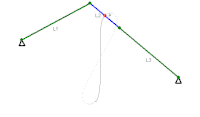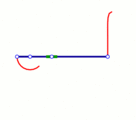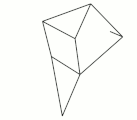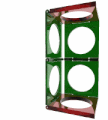Steering wheel guidance
A steering straight guide is a special four- link coupling gear that is used to " guide a coupling point approximately straight on a prescribed route." An exact straight line "is only possible with the isosceles centric slider crank or multi-link coupling gear ...".
Straight-line guidance is used, for example, on the jib of a crane (see illustration), on Evans handlebars , where a pen moves approximately in a straight line, or on the Watt linkage ( lemniscate handlebar ).
Examples: approximately straight leading
Listed with year of invention or publication, a selection:
Watt linkage , 1784, when the paddock revolves, then backwards on another lemniscate branch,
Chebyshev mechanism , 1870s
nonlinear return movement when the paddock rotatesHoecken Mechanism , 1926
Predecessor: Chebyshev Lambda MechanismJansen, 1990, Strandbeest
Imitation of a "foot" going to the rightfour Klann mechanisms , 1998
imitation of four "feet" going to the left
The Watt linkage was invented and used by James Watt for steam engines . Today it is mainly used for the vertical guidance of rigid axles in the transverse plane on automobiles. The coupling point used for this moves on a branch of a very slim lemniscate . In the similar Chebyshev mechanism , the return movement occurs on an arc. This, the hoe and other mechanisms with a similar coupling point path were used as film gripper gears.
The two last gears shown are more than four-link coupling gears. The Strandbeest consists of two 4-part crank arms (with identical crank and frame link), with a two-stroke between the arms . One point of one of the two striking links is the "foot point". The Klann mechanism is a crank swing arm with a double strike between the belt and the frame. One point of the two-beat link hinged to the paddock is the "foot".
Examples: leading exactly straight
List with year of invention or publication:
Tusi Pairs / Cardanic Circles
Each point of the small circle moves on a diameter of the large circle.Sarrus mechanism , 1853
as a spatial coupling gearInversor by Peaucellier , 1864
8-link gearInversor von Hart , 1874/75
6-link gearInversor von Hart , 1874/75
5-part gear
model: A-frameQuadruplanar inverse by Sylvester and Kempe (1875)
The Sarrus mechanism is a spatial coupling gear with special dimensions: its links of equal length not only allow this gear to be moved at all, but also that the coupling moves on an exact straight line. It is used today on foldable boxes .
The other mechanisms shown represent the geometric inversion : A circle (path of a swing end point) is converted into a straight line (path of the output point) through the center of inversion.
Individual evidence
- ↑ Luck, Modler: Getriebetechnik, Springer, 1990, p. 197
- ^ Johannes Volmer : Getriebetechnik, Verlag Technik, 1968, p. 498
- ^ Siegfried Hildebrand, p. 642
- ↑ Dankert / Dankert: Technical Mechanics , Theo Jansens Strandbeest Mechanism












